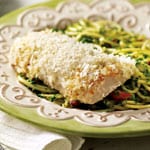Meals, Mediterranean Style
 A Mediterranean style of eating reflects the dietary traditions of the countries that surround the Mediterranean, including fruits and vegetables, legumes, nuts and cereals, olive oil, and fish. Low-to-moderate intake of dairy products and red meat, and moderate intake of wine with meals, are also typical. See the Mediterranean Diet Pyramid for more information about the Mediterranean diet.
A Mediterranean style of eating reflects the dietary traditions of the countries that surround the Mediterranean, including fruits and vegetables, legumes, nuts and cereals, olive oil, and fish. Low-to-moderate intake of dairy products and red meat, and moderate intake of wine with meals, are also typical. See the Mediterranean Diet Pyramid for more information about the Mediterranean diet.
How to get started.
- Make half your plate fruits and vegetables. Incorporate vegetables into your meals either as part of the main dish or as side items. Add vegetables to boost the flavor and nutrition of your favorite comfort classics including casseroles, soups, and stews. Complement your meal with a simple salad or oven-roasted medley of vegetables. Boost your morning cereal or oatmeal with a handful of strawberries or other berries. Keep a bowl of fresh fruit available for quick and easy snacking.
- Put meat to the side. Typically, meat is the center of the plate, but with a Mediterranean style of eating, you have smaller amounts. For example, add diced chicken breast to a vegetable sauté, or thread sirloin tips with peppers and onions on kabobs. As a main course, have smaller portions (3 ounces is the size of a deck of cards) of chicken and lean meat.
- Enjoy dairy products in moderation. Eat Greek or plain yogurt as a parfait with fresh fruit. Use low-fat cheese—including part skim mozzarella or flavorful cheeses such as Brie, feta, or Parmigiano-Reggiano—in smaller amounts.
- Eat low to moderate amounts (up to 3.5 ounces per serving) of seafood twice a week. Tuna, salmon, herring, and sardines are lean sources of protein rich in omega-3 fatty acids. Wrap the fish in parchment paper with lemons, onions, garlic, and herbs. Bake in the oven for a quick and easy dinner.
- Use good fats. Include sources of healthy fats in moderation, especially extra-virgin olive oil, nuts, peanuts, sunflower seeds, olives, and avocados. Mix up a handful of unsalted nuts and dried fruits for a quick snack. Drizzle olive oil on salads and steamed vegetables.
- Switch to whole grains. Whole grains like bulgur, barley, brown rice, quinoa, and farro provide fiber, protein, B vitamins, and iron. Use these grains like rice in your favorite dishes including risottos, pilafs, salads, and soups.
- Satisfy your sweet tooth with fruit for dessert. Serve poached pears or fresh fruit compote to end your meal on a sweet note.
For more information about the Mediterranean diet, visit oldwayspt.org.
For more information about American Heart Month, visit www.cdc.gov.
* "Mediterranean Diet" used courtesy of oldwayspt.org.
1 The Journal of Family Practice. 2013; 62(7): 337-345.
2 Harvard Health Letter. 2013:3
3 A study published in the New England Journal of Medicine in 2013 found that about 30 percent of heart attacks, strokes and deaths from heart disease can be prevented in high-risk people if they switch to a Mediterranean diet. These findings are based on the first major clinical trial to measure the eating approach's effect on heart risks; it ended early, after about five years, because the results were so clear. Researchers say the study's results provide evidence that the diet is a "powerful" tool in reducing heart disease risk, including among those already on statins or blood pressure drugs.

 You are about to leave publix.com and enter the Instacart site that they operate and control. Publix’s delivery and curbside pickup item prices are higher than item prices in physical store locations. Prices are based on data collected in store and are subject to delays and errors. Fees, tips & taxes may apply. Subject to terms & availability. Publix Liquors orders cannot be combined with grocery delivery. Drink Responsibly. Be 21. For prescription delivery, log in to your pharmacy account by using the Publix Pharmacy app or visiting
You are about to leave publix.com and enter the Instacart site that they operate and control. Publix’s delivery and curbside pickup item prices are higher than item prices in physical store locations. Prices are based on data collected in store and are subject to delays and errors. Fees, tips & taxes may apply. Subject to terms & availability. Publix Liquors orders cannot be combined with grocery delivery. Drink Responsibly. Be 21. For prescription delivery, log in to your pharmacy account by using the Publix Pharmacy app or visiting